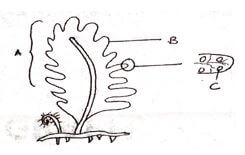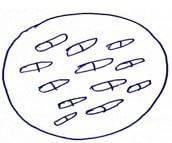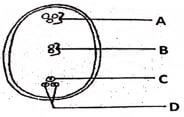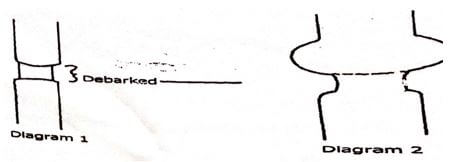- Answer all the questions (80 Marks)

QUESTIONS
- Give two reasons why a cell must undergo interphase before mitosis starts. (2mks)
-
- State three limitations of quadrat method used in estimation of population of organisms in a given ecosystem. (3mks)
- Apart from quadrat method, name any other two methods of estimating populations of organisms (2mks)
- The diagram below represents the sporophyte generation of a fern plant. Study it and answer the questions that follow.

- Name the parts labelled A and B (2mks)
A…………………………….
B……………………………. - Suggest the significance of the structure labelled C (1mk)
- Name the parts labelled A and B (2mks)
- State two importance of aerobic respiration. (2mks)
- Name two sites of respiration in a cell. (2mks)
-
- Differentiate between sickle-cell anaemia and sickle- cell trait. (2mks)
- Name the type of gene mutation that brings about the sickle cell anaemia. (1mk)
- Through which blood vessels does the blood from the alimentary canal return to the heart? (2mks)
- Name two examples of polysaccharides in plants. (2mks)
- The diagram below is a specialized mammalian cell

- Name the parts labelled B and D (2mks)
B……….................................
D………................................ - State how the following parts are adapted to their functions (2mks)
- Part labelled A
- Part marked C
- Name the parts labelled B and D (2mks)
- What is the name given to the pregnancy that occurs in the fallopian tube? (1mk)
- List the causative agent of the following sexually transmitted infections (STls): (2mks)
- Gonorrhoea.
- Syphilis
-
- How would you destarch the leaves of a potted plant? (1mk)
- Which chemical would you use to test for presence of vitamin C in a food substance? (1mk)
- Name the two types of chemical compounds which combine to form a lipid. (2mks)
- Name the processes by which the following enter the root hair cell. (2mks)
- Oxygen.
- Water.
- Give two structural differences between mature white blood cells and red blood cells. (4mks)
- Give two examples of genetic engineering that are intended to improve crop plants. (2mks)
- An animal has 36 chromosomes in each of its body cells. How many of these chromosomes came from its male parent? (1mk)
- Study the diagram below:

- From which type of plant is the section representing? (1mk)
- Give two reasons for your answer in (a) above. (2mks)
-
- Name the organelle involved in formation of cilia and flagella. (1mk)
- Give two strengthening materials of cell wall of plant. (2mks)
- State two homeostatic functions of mammalian kidney. (2mks)
-
- What type of gene mutations are represented by the following messages? (2mks)
- Intended message: Lions have pointed claws.
Actual message: Lions have pointed laws. - Intended message: The strong wind caused severe damage.
Actual message: The strong wind paused severe damage.
- Intended message: Lions have pointed claws.
- At what stage of cell division does exchange of genetic material occur ? (1mk)
- What type of gene mutations are represented by the following messages? (2mks)
- The diagram below shows an embryo sac of a flowering plant

- Name the parts labelled A and D (2mks)
A……………….................
D……………................... - What is the function of structure labelled B (1mk)
- Why is cross pollination more advantageous to a plant species than self-pollination (1mk)
- What name is given to the type of fertilization exhibited in plants (1mk)
- Name the parts labelled A and D (2mks)
-
- What is divergent evolution (1mk)
- Distinguish between divergent and convergent evolution (2mks)
- Name two mechanisms that hinder fertilization in flowering plants (2mks).
- The diagram below represents an experiment that was set up to investigate a certain process

- Name the process that was being investigated (1mk)
- Account for the swelling in diagram 2 (2mks)
- Give a reason why the plant did not dry up during the investigation (1mk)
-
- Name one hormone that is involved in insect metamorphosis (1mk)
- State the site where the above named hormone is produced (1mk)
- State two roles of metamorphosis to the life of insects (2mks)
- Explain why swallowing and breathing cannot take place at the same time (2mks)
- State three properties of a cell membrane (3mks)
- Give a reason why it is only mutation in genes of gametes that influence evolution (1mk)
- State three structural differences between Ribonucleic acid (RNA) and Deoxyribonucleic acid (DNA) (3mks)
- Define the term homeostasis (1mk)
-
- What was the function of the following apparatus. (3mks)
- Pooter
- Sweep net
- Chloroform
- Other than observation, give other two scientific skills developed by studying biology. (2mks)
- What was the function of the following apparatus. (3mks)
-
- What is peristalsis? (1 mk)
- Explain how the process above is brought about. (2mks)
- What are the two functions of bile salts during the process of digestion. (2mks)

MARKING SCHEME
- Give two reasons why a cell must undergo interphase before mitosis starts. (2mks)
- To accumulate enough energy required for cell division;
- To duplicate all the plant structures;
- To allow replication of DNA;
-
- State three limitations of quadrat method used in estimation of population of organisms in a given ecosystem. (3mks)
- Tedious;
- Cannot be used in inaccessible areas like thick forest;
- It cannot be used for fast moving animals;
- The landing of quadrat scares away some animals
- Apart from quadrat method, name any other two methods of estimating populations of organisms (2mks)
- Line transect
- Belt transect
- Capture-recapture method
- State three limitations of quadrat method used in estimation of population of organisms in a given ecosystem. (3mks)
- The diagram below represents the sporophyte generation of a fern plan. Study it and answer the questions that follow.

- Name the parts labelled A and B (2mks)
- A……….Frond
- B……….Pinna
- Suggest the significance of the structure labelled C (1mk)
- Produce spores which germinate into the gametophyte
- Name the parts labelled A and B (2mks)
- State two importance of aerobic respiration. (2mks)
- Energy production;
- Source of metabolic water
- Name two sites of respiration in a cell. (2mks)
- Cytoplasm; Mitochondria
-
- Differentiate between sickle-cell anaemia and sickle- cell trait. (2mks)
- Sickle-cell anaemia is a genetic disorder in which all individual's red blood cells have abnormal haemoglobin S that makes the cells to have crescent shape; sickle- cell trait is a genetic disorder in which the individual have a mixture of normal and abnormal red blood cells
- Name the type of gene mutation that brings about the sickle cell anaemia. (1mk)
- Substitution mutations
- Differentiate between sickle-cell anaemia and sickle- cell trait. (2mks)
- Through which blood vessels does the blood from the alimentary canal return to the heart? (2mks)
- Hepatic vein; vena cava;
- Name two examples of polysaccharides in plants. (2mks)
- Starch; Cellulose
- The diagram below is a specialized mammalian cell

- Name the parts labelled B and D (2mks)
- B………Nucleus
- D………..Tail/Tail piece
- State how the following parts are adapted to their functions (2mks)
- Part labelled A
- Contains/produces lytic enzymes which dissolve the vitelline membrane/wall of egg cell
- Part marked C
- Contains numerous mitochondria which provides the necessary energy used to propel the sperm
- Part labelled A
- Name the parts labelled B and D (2mks)
- What is the name given to the pregnancy that occurs in the fallopian tube? (1mk)
- Ectopic pregnancy
- List the causative agent of the following sexually transmitted infections (STls): (2mks)
- Gonorrhoea.
- Neisseria Gonorrhoea
- Syphilis
- Treponema pallidum
- Gonorrhoea.
-
- How would you destarch the leaves of a potted plant? (1mk)
- Placing the plant in darkness for 48 hours
- Which chemical would you use to test for presence of vitamin C in a food substance? (1mk)
- DCPIP
- How would you destarch the leaves of a potted plant? (1mk)
- Name the two types of chemical compounds which combine to form a lipid. (2mks)
- Glycerol; Fatty acids
- Name the processes by which the following enter the root hair cell. (2mks)
- Oxygen.
- Diffusion
- Water.
- Osmosis
- Oxygen.
- Give two structural differences between mature white blood cells and red blood cells. (4mks)
- White blood cells Red blood cells
- Biconcave discs; Irregular in shape
- Have haemoglobin Lack haemoglobin
- Have nuclei Lack nuclei
- Give two examples of genetic engineering that are intended to improve crop plants. (2mks)
- Coming up with resistant varieties to diseases and drought;
- Producing high yielding crops;
- Breeding of seedless crops like bananas
- An animal has 36 chromosomes in each of its body cells. How many of these chromosomes came from its male parent? (1mk)
- Study the diagram below:

- From which type of plant is the section representing? (1mk)
- Monocotyledous plant
- Give two reasons for your answer in (a) above. (2mks)
- Lack of vascular cambium; No pith; scattered vascular bundles in ground tissue
- From which type of plant is the section representing? (1mk)
-
- Name the organelle involved in formation of cilia and flagella. (1mk)
- Centriole
- Give two strengthening materials of cell wall of plant. (2mks)
- Pectin; Lignin
- Name the organelle involved in formation of cilia and flagella. (1mk)
- State two homeostatic functions of mammalian kidney. (2mks)
- Osmoregulation
- Regulation of blood pH
-
- What type of gene mutations are represented by the following messages? (2mks)
- Intended message: Lions have pointed claws.
- Actual message: Lions have pointed laws.
- Deletion;
- Intended message: The strong wind caused severe damage.
- Actual message: The strong wind paused severe damage.
- Substitution
- Intended message: Lions have pointed claws.
- At what stage of cell division does exchange of genetic material occur (1mk?)
- Prophase I
- What type of gene mutations are represented by the following messages? (2mks)
- The diagram below shows an embryo sac of a flowering plant

- Name the parts labelled A and D (2mks)
- A………………Antipodal cells
- D……………Synergids
- What is the function of structure labelled B (1mk)
- To fuse with the other make nucleus to form the triploid endosperm
- Why is cross pollination more advantageous to a plant species than self-pollination (1mk)
- Results to variation that makes the plant adapted for survival
- What name is given to the type of fertilization exhibited in plants (1mk)
- Double fertilization
- Name the parts labelled A and D (2mks)
-
- What is divergent evolution (1mk)
- Emergence of present forms of organisms gradually from pre-existing ones
- Distinguish between divergent and convergent evolution (2mks)
- Divergent evolution-basic structural form is modified to perform different functions
- Convergent evolution-different structural forms are modified to perform similar function
- What is divergent evolution (1mk)
- Name two mechanisms that hinder fertilization in flowering plants (2mks)
- Heterostyly/unisexual/dioecious/staminate/pistillate flowers
- Protandry
- Protogyny/incompatibility/self-sterility
- The diagram below represents an experiment that was set up to investigate a certain process

- Name the process that was being investigated (1mk)
- Translocation of manufactured food
- Account for the swelling in diagram 2 (2mks)
- Translocated food substances accumulate; it could not get across the ringed part since the phloem tissue was removed
- Give a reason why the plant did not dry up during the investigation (1mk)
- The xylem tissue was not affected hence transport of water and mineral salts to sites of photosynthesis
- Name the process that was being investigated (1mk)
-
- Name one hormone that is involved in insect metamorphosis (1mk)
- Ecdysone
- Juvenile hormone
- State the site where the above named hormone is produced (1mk)
- Ecdysone-Prothoracic gland
- Juvenile-Corpus allatum/corpora allata
- State two roles of metamorphosis to the life of insects (2mks)
- Enables organisms at various stages to occupy different ecological niches thus reducing competition
- Can withstand different environmental conditions at different stages
- Enables organisms at various stages of development to adapt to the environment
- Name one hormone that is involved in insect metamorphosis (1mk)
- Explain why swallowing and breathing cannot take place at the same time (2mks)
- During swallowing the bolus is pressed against the soft palate closing the nasal cavity and the glottis (opening to the larynx) is closed by the epiglottis thus prevent entry of air into the trachea
- State three properties of a cell membrane (3mks)
- Semi permeability
- Possession of electric charges
- Sensitive to extreme changes in temperature and PH
- Give a reason why it is only mutation in genes of gametes that influence evolution (1mk)
- Gametes always form new offsprings and therefore any mutations in gametes affects offsprings
- State three structural differences between Ribonucleic acid (RNA) and Deoxyribonucleic acid (DNA) (3mks)
RNA
DNA
Has Ribose sugars
Has Deoxyribose sugars
Has Uracil as one of the bases
Has Thymine instead of Uracil
Single strand
Double strand
- Define the term homeostasis (1mk)
- Process that maintains constant internal environment of living organisms
-
- What was the function of the following apparatus. (3mks)
- Pooter
- Sucking small animals from barks of a tree
- Sweep net
- Catching small flying insects.
- Chloroform
- To immobilize fast moving organism
- Other than observation, give other two scientific skills developed by studying biology. (2mks)
- Identification, recording, classifying, measuring, analyzing, evaluation.
- What was the function of the following apparatus. (3mks)
-
- What is peristalsis? 1 mark
- Involuntary movement of food along the alimentary canal
- Explain how the process above is brought about. 2marks
- Occurs when the Circular and longitudinal muscles on the wall of oesophagus and intestines contract and relax alternately;
- What are the two functions of bile salts during the process of digestion. 2marks
- Emulsification
- Neutralization of acidic chyme
- What is peristalsis? 1 mark
Download Biology Paper 1 Questions and Answers - Form 4 Term 2 Opener Exams 2022.
Tap Here to Download for 50/-
Get on WhatsApp for 50/-
Why download?
- ✔ To read offline at any time.
- ✔ To Print at your convenience
- ✔ Share Easily with Friends / Students

